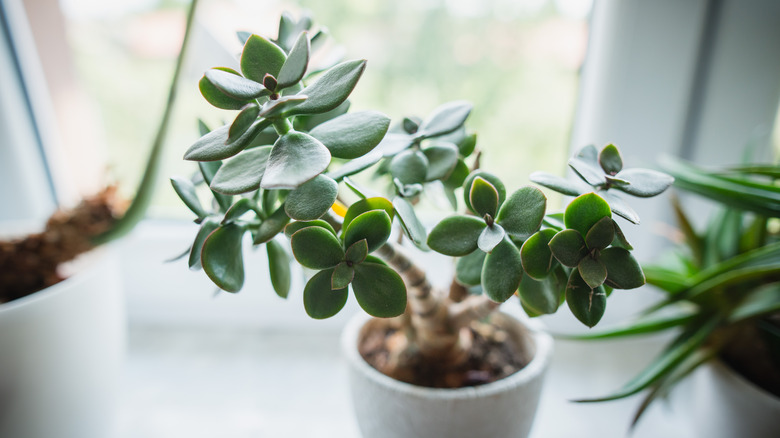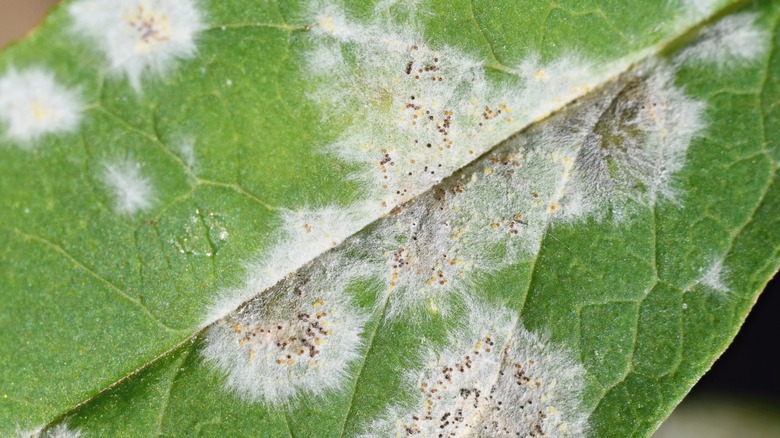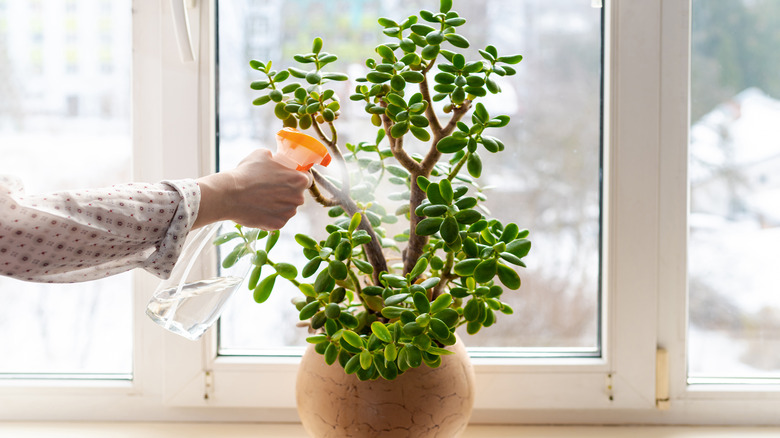What's The Best Way To Treat Powdery Mildew On Jade Plants?
Jade plants are a variety of succulents that make great indoor cultivars. They live for years, growing up to 5 feet tall. Jade plants can be picky, but as long as you provide them with an ideal environment, they will reward you with new growth. They have thick oval-shaped leaves and stems that turn woody as they mature. Almanac explains that jade plants do best in a warm, dry home, and need at least six hours of sunlight a day. The older the plant gets, the more direct light it will need, but keeping a young jade in direct sun will burn its leaves.
These succulents are very specific about the drink they get. They need filtered or distilled water about every two to three weeks since the salts in tap water are too strong for them, resulting in deposits on their leaves. These white spots can look similar to powdery mildew. However, Smart Garden Guide explains that wiping the leaves with a damp paper towel will help you tell the difference. If the spots quickly reappear on the foliage, you are dealing with powdery mildew, not with residue from the tap water.
How to tell if your jade plant has powdery mildew
Powdery mildew is a fungal disease that is harmful to jade plants but doesn't kill them. You can identify it as white or gray spots that commonly appear on the lower leaves. As its name suggests, these patches often look powdery, like flour, or fuzzy, like mildew. This fungal disease needs a humid environment with low air circulation to thrive on your plants, according to Wyman's Home and Garden. Therefore, your houseplant collection is most likely to contract a fungal disease during spring and fall because that's when the environment is ideal for the fungi to appear. This disease is spread through the air via mildew spores that can grow on any part of the plant.
Once this disease takes over your jade plant, you'll notice the infected foliage changing colors. As the cultivar weakens, the leaves will turn yellow or brown. Then, they dry out and drop. The University of Massachusetts Amherst explains that this fungus lives off of living plant tissue, so it won't completely kill your succulent; instead, it will feed off the foliage until it runs out of nutrients and falls off the stems. Luckily, there are ways to prevent your jade plants from getting powdery mildew and methods to treat the infected areas if they get it.
How to get rid of powdery mildew
You need to be consistent to treat your infected jade plant successfully. If you miss a spot, the spores will continue to expose other areas. So, the first thing to do is use disinfected shears to prune your jade off all the infected leaves and stems. Once these are removed, make sure to put them in the garbage. Composting the scraps won't kill the fungus; instead, it will infect any new plants you fertilize with the resulting enricher.
Garden Design recommends multiple ways to treat infected jade plants. Purchasing a sulfur fungicide is an easy method since you only need to apply it generously, spraying the entire plant. This will not only treat your jade but prevent any future powdery mildew. Another option is to create a homemade fungicide. Do this by mixing 1 tablespoon of potassium bicarbonate or baking soda with ½ teaspoon of liquid soap and 1 gallon of water. These blends must be sprayed onto the plant once a week for three to four weeks.
You can prevent powdery mildew by ensuring that your plants get the proper amount of sunlight. These succulents need a lot of direct sun, so if they get that, it will help dry their soil so it doesn't get humid enough for mildew to grow. Finally, another important step is to thin the foliage to allow airflow between the stems. You won't see any more mildew on your plants if you take these preventive measures.


